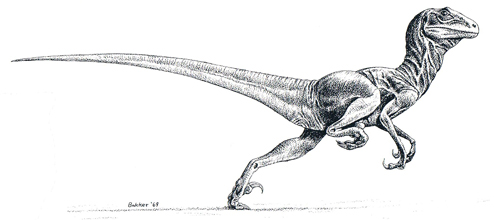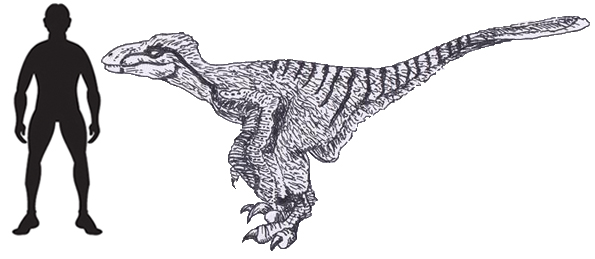Deinonychus – Dinosaur Renaissance
Everything Dinosaur team members have just updated their Deinonychus (D. antirrhopus) fact sheet. From time to time, all our fact sheets get reviewed, revised and updated. The dromaeosaurid Deinonychus has a special place in vertebrate palaeontology, as it was following the publication of a scientific paper by the American palaeontologist John Ostrom in 1969, that the Dinosauria began to be depicted as animals as active as living birds and mammals.
Prior to Ostrom’s seminal paper “Osteology of Deinonychus antirrhopus, an Unusual Theropod from the Lower Cretaceous of Montana” in July 1969, dinosaurs were still largely depicted as slow-witted, slow-moving, cold-blooded reptiles.
The Illustration of Deinonychus from the 1969 Scientific Paper

Picture credit: Robert T. Bakker (1969)
Deinonychus and the “Dinosaur Renaissance”
Ostrom along with his student Robert T. Bakker helped to usher in a “Dinosaur Renaissance”, that dinosaurs were potentially endothermic and the body plan of Deinonychus could only represent an extremely active, agile hunter. Writing in the bulletin (Bulletin 30 – July 1969) of the Peabody Museum of Natural History (Yale University), Ostrom explained:
“A detailed description is presented of the skeletal anatomy and adaptations of Deinonychus antirrhopus (Ostrom 1969), a very unusual carnivorous dinosaur (Order Saurischia, Suborder Theropoda) from the Cloverly Formation (Early Cretaceous) of Montana. The species is characterised by a number of features that indicate an extremely active and agile animal, fleet of foot and highly predaceous in its habits.”
Deinonychus antirrhopus Monograph
In this very detailed monograph (it runs to something like 160 pages), Ostrom even described the likely “habits of Deinonychus”. Ostrom compared the vertebrae to those of living flightless birds such as Moas (Ratites). He concluded that the backbones were held horizontal to the ground and not in the inclined attitude (the kangaroo stance), usually depicted for theropods.
Comments were made about the potential speed of this dinosaur, it was stated that Deinonychus was likely to be a fast runner, but the absence of a femur restricted Ostrom from making specific claims as to the velocity of this obligatory biped. Ostrom did state that the elongated foot bones were reminiscent to those found in deer, the cheetah and in fast-running ground dwelling birds.
Ostrom wrote:
“Regarding locomotion, the hind limbs of Deinonychus appear to have been powerful limbs for moderately, but not unusually fast running.”
This description gave plenty of scope to movie makers when it came to depicting “raptors”, in films such as “Jurassic Park” that were to inspire and thrill in the early 1990’s.
The Scale Drawing of Deinonychus antirrhopus on the Everything Dinosaur Fact Sheet

Picture credit: Everything Dinosaur
The picture (above) shows a typical dromaeosaurid as represented by the Beasts of the Mesozoic model range.
To view this range of articulated models and figures: Beasts of the Mesozoic Dinosaur Models.
No Feathers
We don’t think that the Deinonychus paper published in 1969 mentioned the possibility of this dinosaur having a coat of feathers. After all, despite the holotype material having been preserved in fine clay, which eventually turned to mudstone, no evidence of feathers has been found in association with D. antirrhopus fossil material.
The presence of feathers is inferred based on exquisite feathered dromaeosaurid fossils, most notably from northern China.
Ostrom did however, start to make the connection with Deinonychus and the possibility of this dinosaur being covered in feathers, a year after his ground-breaking paper was published. Whilst viewing what was thought to be a pterosaur fossil from Solnhofen, at the Teylers Museum in Holland, Ostrom identified it as an Archaeopteryx specimen (A. lithographica). He was able to subsequently make the link between the bones preserved on this fossil slab and those of Deinonychus he had described the year before. The idea that dinosaurs and birds were closely related was revived, as Bakker later put it, the “Dinosaur Renaissance” had begun.
Visit the Everything Dinosaur website: Everything Dinosaur.






Leave A Comment